First Jordan Hydro-Electric Power House
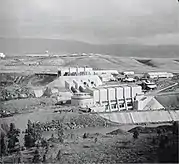
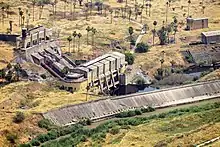
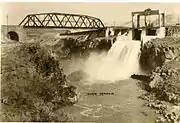
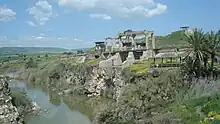
The First Jordan Hydro-Electric Power House, also known as the Rutenberg Power Station or the Naharayim Power Plant or the Tel Or Power Plant, was a conventional dammed hydroelectric power station on the Jordan river, which operated between 1932 and 1948. It was situated in the Emirate of Transjordan (modern Jordan), but built to supply power to Mandatory Palestine (modern Israel). The plant was built in an area known as Jisr el-Majami, later renamed by the Palestine Electric Corporation as Naharayim, and following the Israel–Jordan peace treaty it is today part of the Jordanian area of Baqoura.
The plant was constructed – under concession from the Mandatory government – by Pinhas Rutenberg's Palestine Electric Corporation, based on a plan put forward in 1926. It followed his original 1920 Rutenberg plan to build ten reservoirs and fourteen hydroelectric plants on the Jordan river.[1][2] Financial capital for the project came from the worldwide Jewish community, organized with limited publicity in order to allow Rutenberg to be presented as an "entrepreneur" rather than part of the Zionist Organization.[3]
Concession
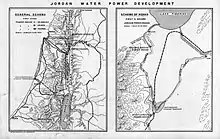
On 8 December 1920, Pinhas Rutenberg submitted a 60 page proposal to the British government, proposing to build 14 hydroelectric power stations along the Jordan River[4] On 21 September 1921, a concession agreement was signed between the British Government and Rutenberg granting him a monopoly over "utilization of such of the waters of the River Jordan and its basin including the Yarmuk River and all other affluents" and a right to "erect a power house near Jisr-el-Mujamyeh".[5] This agreement required Rutenberg to form a company with at least GBP1 million of capital within two years; such company was formed, named the Palestine Electric Corporation (PEC). The concession was then formalized on 5 March 1926 for a 70-year period and validated in Mandatory Palestine by the Electricity Concessions Ordinance 1927 and in the Emirate of Transjordan by the Electricity Concession Law, 1928.[6]
Construction
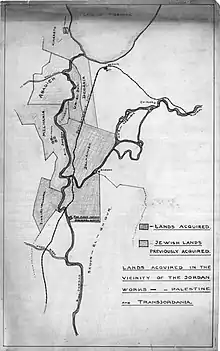
The plant was constructed between 1926 and 1933. About 3000 workers were employed during the construction.[7] Rutenberg's original proposal explained that the location near Jisr el-Majami was the only site on which it was "possible to begin construction of a powerhouse immediately", due to the required proximity to the Sea of Galilee (which would act as a natural reservoir) and because it represented the location which had been most densely settled by Jews.[8] The choice of the location influenced the ongoing Anglo-French discussions over the location of the mandatory borders, which became the Paulet–Newcombe Agreement.[9] A similar dynamic appeared in the finalization of the eastern border with respect to what became known as the "Semakh triangle".[10]
Operation
The plant operated between 1932 and 1948.[1][11][12] The opening ceremony took place on 9 June 1932, attended by Emir Abdullah I of Jordan and British officials including the High Commissioner Arthur Grenfell Wauchope, Colonel Charles Henry Fortnom Cox, and Sir Steuart Spencer Davis.[13]
The plant ceased operations following the 1948 Arab-Israeli war. It was captured and looted by the Iraqi Army on 14 May 1948.[14] Transjordan had a secret agreement with Israel regarding protection of the works.[15] United States Chargé d'affaires Wells Stabler reported in a confidential despatch that when the Iraqi army arrived, the Israeli operators of the plant blew up some of the electricity generators (alternators) in the plant and the plant was subsequently looted by the Iraqi troops.[15] Thirty-eight workers were captured;[16] they were released only after the Armistice Agreements were signed on 3 April 1949.[17] Stabler's despatch on 11 July 1949, written after a visit to the site, read:
It is understood that prior to the hostilities In May 1948, the Jordan Government and the Jewish Agency reached some form of agreement concerning the protection of the Hydro-Electric works. It is possible that the Jordan Government would have been able to observe this agreement if it had not been for the arrival of the Iraqi forces. When the Iraqi forces came into the area, the Israelis departed, but only after blowing up certain of the dynamos in the main dynamo building. Later the Iraqi finished the job, even removing numerous machines.... The area has been under the control of the Arab Legion since the departure of the Iraqi troops three months ago. All looting and damage has been stopped by the Legion and the area is under guard. ... It is quite obvious that the Rutenberg Hydro-Electric works can only be operated again by an agreement between Jordan and Israel. Jordan, on its part, is incapable of operating such a works by itself and, moreover, the Israelis can control the flow of the Jordan. Israel, on the other hand, cannot commence operations of the works as all the buildings are in Jordan territory. In addition, Jordan can control the flow of the Yarmuk River. It would appear that it would take some time yet to reach an agreement on the operation of the Rutenberg Hydro-Electric works as it remains, along with the Dead Sea Potash Works, an important bargaining point for Jordan.[15]
1948 proposals to reopen
Various proposals were made for cooperation between Israel and Jordan regarding the use of the Jordan river in the wake of the 1948 war.[18][19] After an armistice agreement was signed PEC executives proposed to open the plant but the Jordanian king refused.[17] Proposal to apply the seven-state Tennessee Valley Authority scheme to the area was submitted to the United Nations in 1953,[18][19] stating:
Near the junction of the Jordan and Yarmuk Rivers is located the Tel Or hydroelectric plant with an installed capacity reported to be about 18,000 kilowatts. It was designed to use waters of both of these rivers, and to make use of Lake Tiberias for storage purposes. The unified development of the Jordan Valley waters giving primary consideration to irrigation uses will result in diverting most of the Yarmuk and Jordan waters from the Tel Or plant and will make its operation entirely in-feasible. It is at present reported to be incapable of being operated, and its repair and replacement for permanent service seems to be entirely unjustified, if the overall plan herein proposed is to be followed. The plant might be repaired and used during the development period as a temporary source of power for construction purposes.
— The Unified Development of the Water Resources of the Jordan Valley Region[20]
Tourism
After the Israel–Jordan peace treaty of 1994, the so-called "Peace Island" at the confluence of the Yarmuk and Jordan has become a tourist attraction,[21][22] with plans to include visits to the actual power plant (the building with the turbines that lies south of Peace Island) sometime in the future. The 2019 cooling-down in the bilateral relations, with Jordan withdrawing the 25-year special arrangement for Naharayim/Baqoura, meant that the Peace Island became a no-go area for tourists,[21] before any plans regarding the power plant were put into practice.
Gallery
 1921 Agreement for the Granting of a Concession for the Utilization of the Waters of the Rivers Jordan and Yarmuk and their affluents for generating and supplying Electrical Energy
1921 Agreement for the Granting of a Concession for the Utilization of the Waters of the Rivers Jordan and Yarmuk and their affluents for generating and supplying Electrical Energy Rutenberg caricatured in Punch on 7 June 1922, whilst the concession was being actively discussed during the British House of Lords debates on the Mandate for Palestine.
Rutenberg caricatured in Punch on 7 June 1922, whilst the concession was being actively discussed during the British House of Lords debates on the Mandate for Palestine. 1927 documents containing the concession as signed in 1926 and their passage into Palestinian law
1927 documents containing the concession as signed in 1926 and their passage into Palestinian law 1928 General Scheme plan
1928 General Scheme plan Under construction 1930
Under construction 1930 Opening ceremony
Opening ceremony Front page of the Arabic newspaper Falastin on the 15th anniversary of the Balfour Declaration, 2 November 1932. The power plant is shown in the top left corner of the cartoon (Arabic: مشروع كهرباء روتنبرغ, romanized: Mashrue Kahraba' Rutenburgh, lit. 'Rutenberg Electricity Project')
Front page of the Arabic newspaper Falastin on the 15th anniversary of the Balfour Declaration, 2 November 1932. The power plant is shown in the top left corner of the cartoon (Arabic: مشروع كهرباء روتنبرغ, romanized: Mashrue Kahraba' Rutenburgh, lit. 'Rutenberg Electricity Project') General view 1935
General view 1935 Interior of power station 1935
Interior of power station 1935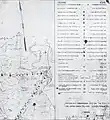 1936 diagram of the transmission lines leading from the plant
1936 diagram of the transmission lines leading from the plant 1935 General Scheme plan
1935 General Scheme plan Cross section
Cross section Longitudinal section
Longitudinal section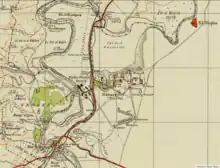 1940s Survey of Palestine map
1940s Survey of Palestine map
Relevant documents
- P. Rutenberg, "Water Resources of Palestine, I. Jordan Valley, Preliminary Project", a Confidential Report issued in Jerasalem, dated June 1920, bilingual (English and Hebrew), pp. 61 (Rutenberg proposal, 8 Dec. 1920, TNA CO 733/9)
- The Crown Agents for the Colonies and Mr. Pinhas Rutenberg, "Agreement for the Granting of a Concession for the Utilization of the Waters of the Rivers Jordan and Yarmouk and Their Affluents for Generating and Supplying Electrical Energy", witnessed by Burchells Solicitors of Westminster, London; Herbert Oppenheimer Nathan and Vandyk, Solicitors, London; and Harry Sacher, Barrister at Law and Notary Public, Jerusalem, dated 21 September 1921.
- 5 March 1926 concession agreement
- "Official Gazette No. 177", Princedom of Transjordan, 1928.
- House of Commons discussions:
Bibliography
- Meiton, Fredrik (15 January 2019). Electrical Palestine: Capital and Technology from Empire to Nation. University of California Press. ISBN 978-0-520-96848-6.
- Meiton, Fredrik (2015). "The Radiance of the Jewish National Home: Technocapitalism, Electrification, and the Making of Modern Palestine". Comparative Studies in Society and History. 57 (4): 975–1006. doi:10.1017/S0010417515000419. S2CID 152010794.
- Shamir, Ronen (6 November 2013). Current Flow: The Electrification of Palestine. Stanford University Press. ISBN 978-0-8047-8868-7.
- Smith, Barbara J. (1 July 1993). "Monopoly Rights for Jewish Enterprise". The Roots of Separatism in Palestine: British Economic Policy, 1920-1929. Syracuse University Press. ISBN 978-0-8156-2578-0.
- Reguer, Sara (1995). "Rutenberg and the Jordan River: A Revolution in Hydro-Electricity". Middle Eastern Studies. 31 (4): 691–729. doi:10.1080/00263209508701076. JSTOR 4283757.
References
- Sofer, Arnon (1999). Rivers of Fire: The Conflict Over Water in the Middle East. Rowman & Littlefield. p. 155. ISBN 978-0-8476-8511-0.
- Reguer 1995, pp. 692.
- Smith 1993, pp. 118–121.
- Meiton, 2015, cites Rutenberg proposal, 8 December 1920, CO 733/9
- Agreement for the Granting of a Concession for the Utilization of the Waters of the Rivers Jordan and Yarmouk and Their Affluents for Generating and Supplying Electrical Energy
- Survey of Palestine. Vol. II. p. 973.
- Shmuel, Avitzur. "The Power Plant on Two Rivers". Israel Ministry of Foreign Affairs. Retrieved 19 April 2020.
- Meiton 2015, p. 994.
- Meiton 2015, p. 996.
- Gil-Har, Yitzhak (1993). "British Commitments to the Arabs and Their Application to the Palestine-Trans-Jordan Boundary: The Issue of the Semakh Triangle". Middle Eastern Studies. 29 (4): 690–701. doi:10.1080/00263209308700974. JSTOR 4283600.
- "Advertisement by the Palestine Electric Corporation". Brochure for the Jewish Palestine Pavilion at the 1939 New York World's Fair. New York, Pavilion Publications]. 1939. p. 57.
- "Chapter XIII: Section 4: A Survey of Industry: Electric Supply in Palestine: Palestine Electric Corporation Ltd". Survey of Palestine. p. 533.
- Reguer 1995, p. 721.
- Gelber, Yoav (1997). Jewish-Transjordanian Relations, 1921-48. Psychology Press. p. 283.
- Foreign Relations of the United States, 1949: The Near East, South Asia, Africa (Chapter: Israel). State Department Historical Office. 1976. pp. 981, reference to Despatch 65 from Amman, 890i.6463/7-1149.
- Schayegh, Cyrus; Arsan, Andrew (5 June 2015). The Routledge Handbook of the History of the Middle East Mandates. Routledge. p. 302. ISBN 978-1-317-49706-6.
- Meiton, 2019, p.214
- Sosland, Jeffrey K. (5 June 2008). Cooperating Rivals: The Riparian Politics of the Jordan River Basin. SUNY Press. pp. 221–. ISBN 978-0-7914-7202-6.
- Smith, C.G. (1966). "The Disputed Waters of the Jordan". Transactions of the Institute of British Geographers (40): 111–128. doi:10.2307/621572. JSTOR 621572.
- "The Unified Development of the Water Resources of the Jordan Valley Region". 1953.
prepared at the request of the U.N. This plan, drawn up by Charles T. Main, Inc., under the direction of the Tennessee Valley Authority
- "Gate closes at 'Isle of Peace' park as border lands to return to Jordan". Times of Israel. 9 November 2019. Retrieved 17 September 2021.
Visitors take likely final tour of Naharayim
- "Regional NGO Master Plan for Sustainable Development in the Jordan Valley: Final Report – June 2015" (PDF). EcoPeace Middle East. 2015. p. 63 ("The Hydroelectric power station at Bakoura/Naharyim"). Retrieved 17 September 2021.
External links
 Media related to First Jordan Hydro-Electric Power House at Wikimedia Commons
Media related to First Jordan Hydro-Electric Power House at Wikimedia Commons